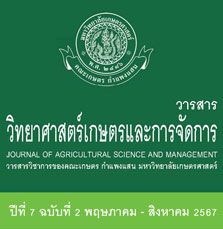Efficiency Test of Antagonistic Microorganisms to Control Rice Brown Spot Disease
Keywords:
leaf brown spot disease, antagonistic microorganisms, biological controlAbstract
Efficiency test of antagonistic microorganisms in inhibiting the growth of Bipolaris oryzae, causes of brown spot disease of rice in laboratory condition by using dual culture method was performed. It was found that the percentage inhibiting growth of pathogenic fungus was 34.96-57.64%. Torulaspora indica DMKU-RP31 and Bacillus amyloliquefaciens inhibited the growth of B. oryzae the most, followed by Trichoderma asperellum (CB-Pin-01) with inhibition percentage of 57.64, 57.63 and 54.86%, respectively. The efficacy of rice brown spot control was tested in greenhouse conditions by soaking rice seeds in cell or spore suspension of antagonistic microorganisms and spraying rice plants for 3 times, comparing to the control and chemical (carbendazim) treatments. The result showed that when the rice was 65 days old, B. amyloliquefaciens, T. indica DMKU-RP31 and T. asperellum (CB-Pin-01) treatments could reduce the occurrence of disease. The B. amyloliquefaciens treatment reduced disease incidence by 54.17%, when compared to the control treatment.
References
กนกวรรณ วัฒนากร และ พรไพรินทร์ รุ่งเจริญทอง. 2558. ผลของไคโตซานต่อการเจริญเติบโตและระดับการเกิดโรคใบจุดสีน้ำตาลในข้าวเจ้าหอมนิล. หน้า621-629. ใน: การประชุมวิชาการระดับชาติ ครั้งที่ 12 มหาวิทยาลัยเกษตรศาสตร์ วิทยาเขตกำแพงแสน นครปฐม
จินตนา อันอาตม์งาม. 2562. เทคนิควิจัยเชื้อราสาเหตุโรคพืช. สำนักพิมพ์ศูนย์ส่งเสริมและฝึกอบรมการเกษตรแห่งชาติ มหาวิทยาลัยเกษตรศาสตร์ วิทยาเขตกำแพงแสน, นครปฐม. 166 หน้า.
จิระเดช แจ่มสว่าง, วรรณวิไล อินทนู และ บังอร น้อยใสย์. 2560. ประสิทธิภาพของชีวภัณฑ์ Bacillus siamensis RRK1-Rif ในการลดการเกิดโรคกาบใบแห้ง และลดโรคเมล็ดด่างของข้าว. วารสารวิทยาศาสตร์เกษตร 49(1): 1-14.
ชนสิริน กลิ่นมณี และ เสาวนีย์ ศรีบัว. 2561. การใช้จุลินทรีย์ปฏิปักษ์ควบคุมโรคใบจุดสีน้ำตาลข้าว. หน้า 132-140. ใน:เอกสารประกอบการประชุมวิชาการข้าวและธัญพืชเมืองหนาว ครั้งที่ 35. โรงแรมแซนด์ ดูนส์ เจ้าหลาว บีช รีสอร์ท. จันทบุรี.
ดารา เจตนะจิตร, นงรัตน์ นิลพานิชย์, พากเพียร อรัญนารถ, วิชิต ศิริสันธนะ, วิชชุดา รัตนากาญจน์, รัศมี ฐิติเกียรติพงศ์, วันชัย โรจนหัสดิน และ ธัญลักษณ์ อารยาพันธ์. 2550. โรคข้าวและการป้องกันกำจัด. สำนักวิจัยและพัฒนาข้าว กรมการข้าว. กรุงเทพฯ. 68 หน้า.
บรรเจิด อินหว่าง และจิระเดช แจ่มสว่าง. 2529. การควบคุมโรคโคนเน่าของมะเขือเทศ (Rhizoctonia solani Kuehn) โดยจุลินทรีย์จากดินเกษตรกรรม. หน้า 173-185. ใน: การประชุมวิชาการสาขาพืช ครั้งที่ 24. มหาวิทยาลัยเกษตรศาสตร์ กรุงเทพฯ
ปัณณวิชญ์ เย็นจิตต์, ธิดา เดชฮวบ และวาริน อินทนา. 2560. การประยุกต์ใช้ร่วมกันของผงเชื้อ Trichoderma sp. และ Bacillus sp. ต่อการควบคุมโรคเมล็ดด่างที่เกิดจาก Bipolaris oryzae ในข้าว. วารสารวิทยาศาสตร์เกษตร 49(1): 15-26.
พราวมาส เจริญรักษ์. 2558. ประสิทธิภาพของเชื้อราปฏิปักษ์ Trichoderma asperellum ในการลดโรคเมล็ดด่าง ส่งเสริมการเจริญเติบโต และเพิ่มผลผลิตของข้าว. วิทยานิพนธ์ปรัชญาดุษฎีบัณฑิต. มหาวิทยาลัยเกษตรศาสตร์ กำแพงแสน นครปฐม. 194 หน้า.
รัศมี ฐิติเกียรติพงศ์, วันพร เข็มมุกด์, วิชชุดา รัตนากาญจน์ และ นิพนธ์ บุญมี. 2554. ประสิทธิภาพของเชื้อแบคทีเรียปฏิปักษ์และสารจากพืชบางชนิดในการควบคุมโรคเมล็ดด่างของข้าว. หน้า 242-247. ใน: สัมมนาวิชาการกลุ่มศูนย์วิจัยข้าวภาคเหนือตอนบนและภาคเหนือตอนล่าง. ม.ป.ท. กรมการข้าว สำนักวิจัยและพัฒนาข้าว.
สำนักงานเศรษฐกิจการเกษตร กระทรวงเกษตรและสหกรณ์. 2565ก. สมาคมผู้ส่งออกข้าวไทย. ผลพยากรณ์การผลิตข้าวปี2560-2565 (ระบบออนไลน์). แหล่งข้อมูล: www.thairiceexporters.or.th/production.htm (24 มีนาคม 2566).
สำนักงานเศรษฐกิจการเกษตร กระทรวงเกษตรและสหกรณ์. 2565ข. สมาคมผู้ส่งออกข้าวไทย. สรุปข่าวประจำสัปดาห์ ประจำวันที่ 25-31 มกราคม 2566 (ระบบออนไลน์). แหล่งข้อมูล: www.thairiceexporters.or.th/mk_rpt/2023/news_1FEB2023CFUQz.pdf (24 มีนาคม 2566).
Abdel-Fattah, G.M., Y.M. Shabana, A.E. Ismail and Y.M. Rasha. 2007. Trichoderma harzianum: a biocontrol agent against Bipolaris oryzae. Mycopathologia 164(2): 81-89.
Ahmad, F., I. Ahmad and M.S. Khan. 2008. Screening of free-living rhizospheric bacteria for their multiple plant growth promoting activities. Microbiological Research 183: 173-181.
Benitez, T., A. Rincón, M. Limón and A. Codón. 2004. Biocontrol mechanisms of Trichoderma strains. International Microbiolology 7: 249-260.
Into, P., P. Khunnamwong, S. Jindamoragot, S. Am-in, W. Intanoo and S. Limtong. 2020. Yeast associated with rice phylloplane and their contribution to control of rice sheath blight disease. Microorganisms 8(3):362, doi:10.3390/microorganisms8030362
Khalili, E., M. Sadravi, S. Naeimi and V.Khosravi. 2012. Biological control of rice brown spot with native isolates of three Trichoderma species. Brazil Journal Microbiology 43: 297-305.
Limtong, S., P. Into and P. Attarat. 2020. Biocontrol of rice seedling rot disease caused by Curvularia lunata and Helminthosporium oryzae by epiphytic yeasts from plant leaves. Microorganisms 8(5):647, doi.org/10.3390/microorganisms8050647
Manamgoda, D.S., A.Y. Rossman, L.A. Castlebury, P.W. Crous, H. Madarid, E. Chukeatirote and K.D. Hyde. 2014. The genus Bipolaris. Studies of Mycology 79: 221-288.
Nagy, A., L. Manczinger, D. Tombácz, L. Hatvani, J. GyÖrfi, Z. Antal, E. Sajben, C. VágvÖlgyi and L. Kredics. 2012. Biological control of oyster mushroom green mold disease by antagonistic Bacillus species. Biological Control of fungal and Bacterial Plant Pathogens IOBC-WPRS Bulletin 78: 289-293.
Nazari, S., M. Javan-nikkhah, K.B. Fotouhifar, V. Khosravi and A. Alizadeh. 2015. Bipolaris species associated with rice plant: pathogenicity and genetic diversity of Bipolaris oryzae using rep-PCR in Mazandaran province of Iran. Journal of Crop Protection 4(4): 497-508.
Ou, S.H. 1985. Rice Disease. Commonwealth Mycological Institute. Ferry Lane, UK. 380 pp.
Tojo, S., Y. Tanaka and K. Ochi. 2015. Activation of antibiotic production in Bacillus spp. by cumulative drug resistance mutations. American Society for Microbiology Journal 59(12): 7799-7804.






